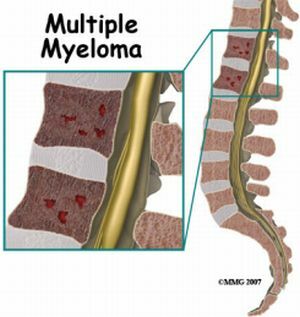 Tumors in the spine are quite rare, often in older people.
Tumors in the spine are quite rare, often in older people.
Cancer formations can be both benign and malignant in nature.
To benign neoplasms it is possible to carry:
- osteoid osteoma;
- osteoblastoma;
- aneurysmal bone cyst;
- chordoma;
- eosinophilic granuloma;
- giant cell tumor.
The types of malignant lesions in the spine are as follows:
- metastatic formations;
- plasmacytoma or Rustitzky-Kahler's disease( the most common type of bone cancer);
- osteogenic sarcoma( takes the second place);
- leukemia.
Contents of the article
- Plasmocytoma - what is it?
- Causes of the disease
- Species of the disease
- Signs and symptoms
- Therapy of the disease
- Folk methods of treatment
- Complications
- Forecast sad
- Remission
Plasmocytoma - what is it?
Myeloma or plasmacytoma is characterized as bone marrow cancer, which is altered plasma cells that no longer perform their functions and cease to produce B-lymphocytes. The latter participate in the exercise of the functions of the human immune system.
Mutated cells do not enter the blood, but they produce atypical immunoglobulins( paraproteins) in it. This is accompanied by deposition in the tissues of amyloid, which leads to violations in the work of various organs - the heart, joints, kidneys.
The plasmacytoma disease is most often diagnosed in the elderly, over 60 years old, and in men it is somewhat more frequent than in women.
Very rarely, the disease occurs in people under 40 years. The causes and etymology of the onset of this ailment are unknown to date.
The causes of the disease
The nature of the disease is still not fully understood, but according to experts, there are a number of reasons that  or otherwise can lead to plasmacytoma:
or otherwise can lead to plasmacytoma:
- tetanus infection, tuberculosis, pyelonephritis, hepatitis, cholecystitis and other diseases,which can act as a stimulus to the production of antigens;
- genetic predisposition;
- changes in T-cell suppression.
- radioactive radiation and prolonged intoxication.
Despite the fact that the course of the disease has already been thoroughly studied, the true causes of its occurrence are still unknown.
Plasma cells that produce paraprotein are present in every human body, but the immune system of healthy people can suppress them.
Varieties of the
The plasmacytoma may vary depending on factors such as the nature of the myeloma cells themselves, their spread, and the type of paraprotein produced.
Depending on the distribution, the following are distinguished:
- diffuse myeloma;
- diffuse-focal;
- focal.
The cellular composition can be distinguished:
- plasmoblast;
- plasmacytic;
- small-celled;
- is polymorphonuclear.
Regarding the nature of paraproteins, myelomas are distinguished:
- is not secretive;
- are diclone;Bens-Jones
- ;
- type M-, A- and G-myeloma.
Symptoms and Symptoms of
The initial stage of the disease can be asymptomatic and can only be manifested clinically - an increase in the ESR index in the patient's blood test.
Further the patient can feel a general malaise, weakness, lose weight and feel pain in the bones. The most common symptom in myeloma is pain in the bones.
Other external and internal manifestations are a consequence of changes in the bone tissue of the person( anemia, increased blood density, impaired kidney function, etc.).
Pain, as a rule, is localized in the area of the spinal column and ribs, and is manifested mainly during movements. In some areas, the pain syndrome may be of a permanent nature, which most often indicates the presence of fractures in this area.

Often in patients with myeloma, there is a symptom such as susceptibility to various infections, dictated by a general decline in the human immune system.
Almost half of patients suffer from concomitant diseases associated with kidney function.
Density and high blood viscosity provokes neurological symptoms, for example, headaches, fatigue, visual impairment. Often patients complain of numbness or tingling in the hands and feet.
With the progression of the disease, there is an increasing anemia associated with the replacement of the bone marrow with cancer cells that disrupt the hematopoiesis in the body. There are cases when it is anemia that is the main symptom throughout the course of the disease.
Therapy of the disease
The choice of treatment methods, like other cancers, depends on the stage and prevalence of the process. There are two types of disease course:
- Sluggish , when the disease progresses very slowly and this process can last up to 10 years( 10% of patients).In such cases, therapy is rarely used.
- Rapidly progressive - when the process of formation of pathogenic cells occurs very quickly. In this case, it is expedient to use medicamentous treatment as soon as possible.
At present, the following methods are used to treat myeloma: 
- chemotherapy - exposure to cancer cells with toxins that destroy them;
- radiotherapy - use of ionizing radiation;
- bone marrow transplantation or stem cells ;
- Surgical intervention - removal of the destroyed bone under the condition of a single plasmacytoma.
Treatment aimed at eradicating the plasmacytoma is accompanied, as a rule, by concomitant therapy with drugs designed to improve the patient's quality of life, relieve pain, increase hemoglobin levels in the blood, and so on.
Subject to positive dynamics, treatment is continued for 1-2 years.
Folk methods of treatment
All drugs and their use should be discussed and coordinated with the treating physician.
Examples of non-traditional medicine prescriptions:
- One of the symptoms of myeloma is the increased viscosity of the blood, with which will help fight .One tablespoon of herbs for a glass of boiling water, insist one hour and drain. Take should be three times a day for a quarter of a glass before meals. The plant has antitumor and blood thinning effects.
- Scaffold vesolistny has a good antitumor effect, improves kidney function and reduces pain in the bones. One teaspoon of plant flowers should be poured a glass of boiling water, let it brew for an hour, strain and take three times a day half a glass before eating.
- Improve the kidneys will help infusion using Veronica drug .It is necessary to squeeze out two teaspoons of juice from the plant and mix it with the same amount of goat's milk. Take the mixture in the morning on an empty stomach.
Complications of
With plasmacytoma, depending on the stage and rate of progression of the disease, a number of complications are possible:
- renal dysfunction;
- neurological symptoms;
- affection of the central nervous system;
- pinched nerves, compression fractures of bones;
- amyloidosis;
- Fanconi syndrome and others.
Forecast sad

On the photo myeloma of the pelvis
Complete recovery of patients with myeloma is extremely rare. Modern medicine allows you to extend the life of the patient on average to 5 years, instead of 1-2 years without treatment .
The lifespan of the patient depends on its sensitivity to the drugs, so patients with primary resistance to cytostatics used in chemotherapy have an average survival rate of up to one year.
Prolonged chemotherapy increases the risk of acute leukemia - in 2-5% of cases. Also, the stage on which oncology is diagnosed plays an important role.
The cause of death can be disease progression, acute renal failure, sepsis, stroke and others.
Remission
Long-term remission is possible:
- with timely access to a doctor;
- in the absence of concomitant severe diseases;
- with good sensitivity to drugs, positive dynamics and minimal side effects.
Each patient's treatment is selected individually, in order to control the process. Complex measures( chemotherapy and hormonal preparations) are used, which allow achieving good results.
Practice shows that proper treatment can increase a patient's life expectancy to 10 years.
Unfortunately, human myeloma gives a very unfavorable prognosis. Mortality is high, there are very few cases of complete cure. All that medicine can do today is to increase life and improve its quality.
If you have any symptoms, you should immediately contact a specialist to diagnose the disease. Timely treatment and adequate treatment is a chance to survive.



